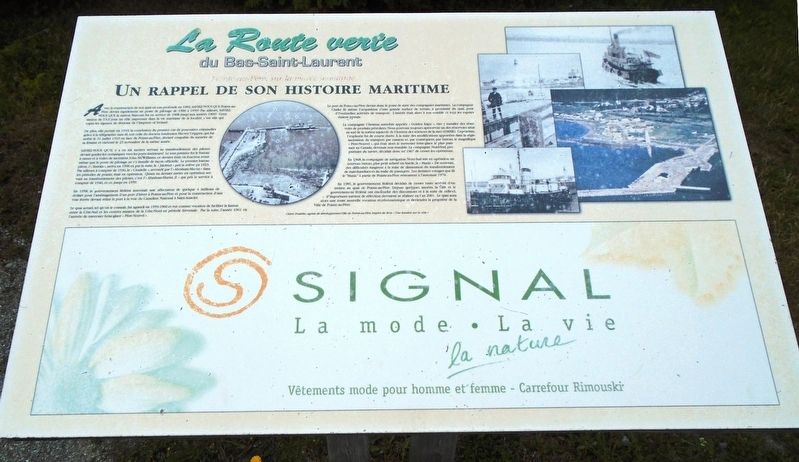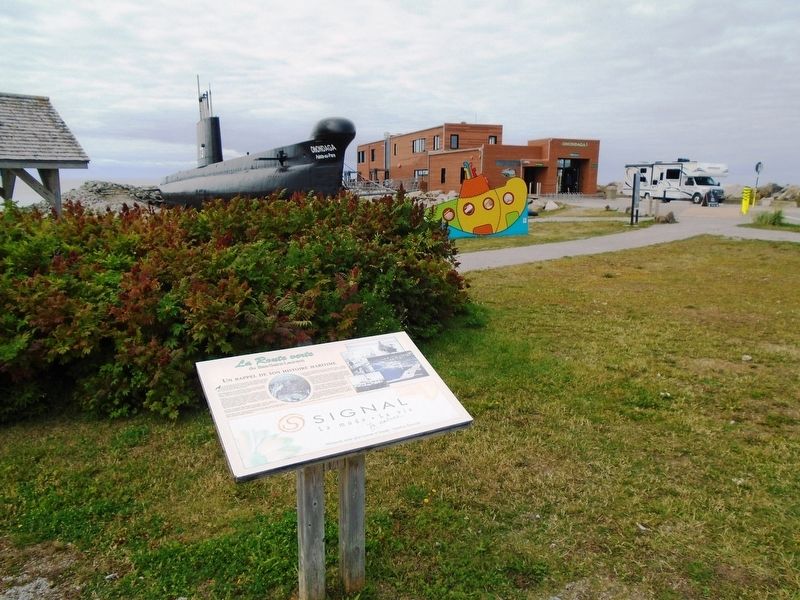Pointe-au-Père, sur la marée montante / on the rising tide
Un rappel de son histoire maritime / A reminder of its maritime history
— La Route verte du Bas-Saint-Laurent / The Lower Saint Lawrence Green Route —
Avec la construction de son quai en eau profonde en 1902, SAVIEZ-VOUS QUE Pointe-au-Père devint rapidement un poste de pilotage de 1906 à 1959? Par ailleurs, SAVIEZ-VOUS QUE la station Marconi fut en service de 1908 jusqu'aux années 1960? Cette station de T.S.F. [télégraphie sans fil] joua un rôle important dans la vie maritime de la localité, c'est elle qui capta les signaux de détresse de l'Empress of Ireland.
De plus, elle permit en 1910, la conclusion du premier cas de poursuites criminelles grâce à la télégraphie sans fil, soit celle du docteur londonien Harvey Crippen, qui fut arrêté le 31 juillet 1910 en face de Pointe-au-Père, déclaré coupable du meurtre de sa femme et exécuté le 23 novembre de la même année.
SAVIEZ-VOUS QU'IL y a eu six navires servant au transbordement des pilotes devant guider les océaniques vers les ports intérieurs? Le tout premier fut le bateau à rames et à voiles de monsieur John McWilliams, ce dernier était en fonction avant même que le poste de pilotage ne s'y installe de façon officielle. Le premier bateau pilote, l'« Eureka », arriva en 1906 et, par la suite le « Jalobert
» prit la relève en 1923. Par ailleurs, à compter de 1936, le « Citadelle », secondé par l'« Abraham-Martin » dans les périodes de pointe, était en opération. Quant au dernier navire en opération servant au transbordement des pilotes, c'est l'« Abraham-Martin II » qui prit le service à compter de 1946, et ce, jusqu'en 1959.En 1958, le gouvernement fédéral autorisait une affectation de quelque 4 millions de dollars pour l'aménagement d'un port d'hiver à Pointe-au-Père et pour la construction d'une voie ferrée devant relier le port à la voie du Canadien National à Saint-Anaclet.
Le quai actuel, tel qu'on le connaît, fut agrandi en 1959-1960 et eut comme vocation de faciliter la liaison entre la Côte-Sud et les centres miniers de la Côte-Nord en périod hivernale. Par la suite, l'année 1961 vit l'arrivée du traversier brise-glace « Père-Nouvel ».
Le port de Pointe-au-Père devint donc le point de mire des compagnies maritimes. La compagnie Clarke fit même l'acquisition d'une grand surface de terrain, à proximité du quai, pour d'éventuelles activités de transport. L'intérêt était alors à son comble et tous les espoirs étaient permis.
La compagnie Ultramar, autrefois appelée « Golden Eagle », vint y installer des réservoirs de produits pétroliers. Nous pouvons toujours apercevoir un des réservoirs situé au sud de la station aquicole de l'Institut des sciences de la mer
En 1968, la compagnie de navigation Nord-Sud mit en opération un nouveau bateau, plut petit acheté en Suède, le « Manic ». De nouveau, des difficultés surgient à la suite de diminution du transbordement de marchandises et du trafic de passagers. Les derniers voyages que fit le « Manic » à partir de Pointe-au-Père remontent à l'automne 1970.
En 1981, le gouvernement fédéral décidait de cesser toute activité d'entretien au quai de Pointe-au-Père. Depuis quelques années, la Ville et le gouvernement fédéral ont enclenche des discussions et à la suite de celle-ci, d'importants travaux de réfection devraient se réaliser en l'an 2001. Le quai aura alors une toute nouvelle vocation récréotouristique et deviendra la propriété de la Ville de Pointe-au-Père.
Claire Fradette, agente de développement Ville de Pointe-au-Père. Inspiré du livre « Une lumière sur la côte[: Pointe-au-Père, 1882-1982] »
With the construction of its deep
Moreover, in 1910, it allowed the first case of criminal prosecution by wireless telegraphy, that of London doctor Harvey Crippen, who was arrested on July 31, 1910, aboard ship near Pointe-au-Père. He was later convicted of murdering his wife, then executed on November 23 that same year.
DID YOU KNOW that there were six vessels used to transfer pilots to guide the ocean liners to inland ports? The first was the rowing and sailing boat of Sir John McWilliams, who was on duty even before the pilot station was officially established. The first pilot boat, the "Eureka," arrived in 1906 and later "Jalobert" took over in 1923. Moreover, starting in 1936, the "Citadel," assisted by the "Abraham Martin" in peak periods, was in operation. As for the last operational ship used for pilot transshipment, the "Abraham Martin II" took service from 1946 until 1959.
In 1958, the federal government authorized an allocation of some $4 million for the construction of a winter harbor at Pointe-au-Père and for the construction of a railway line to connect the port with the Canadian National Railway in Saint-Anaclet.
The current wharf, as we know it, was enlarged in 1959-1960 and was intended to facilitate the connection between the South Shore and the mining centers of the Côte-Nord [North Shore] in winter. Subsequently, the year 1961 witnessed the arrival of the icebreaker ferry "Père-Nouvel."
The Pointe-au-Père port became the focus of shipping companies. The Clarke company even bought a large piece of land near the wharf for possible transport activities. Interest was then at its peak and all hopes seemed possible.
The Ultramar company, formerly known as "Golden Eagle," installed tanks for petroleum products; one can still be seen south of the Institute of Ocean Sciences (ISMER) Aquaculture Station. However, the euphoria was short-lived. As a result of the changes in trucking regulations and, consequently, shipping regulations, the magnificent "Père-Nouvel," which was then the most powerful ice-breaking ferry in Canada, became unprofitable. The North-South shipping company, owner of the vessel, decided in 1967 to stop operating the ferry.
In 1968, North-South purchased a new, smaller boat in Sweden, and put the "Manic" into operation. Again, difficulties arose as a result of reduced transshipment of goods and passenger traffic. The "Manic" made its last runs from Pointe-au-Père in the fall of 1970.
In 1981, the federal government decided to stop all maintenance activities at the Pointe-au-Père wharf. In recent years, the city and federal government initiated discussions, with major renovations expected to take place in 2001. The wharf will then have an entirely new recreational tourism vocation and will become City of Pointe-au-Père property.
Claire Fradette, City of Pointe-au-Père Development Officer. Inspired by the book "A Light on the Coast[: Pointe-au-Père, 1882-1982]"
Erected by Boutique Signal Inc. and Others.
Topics. This historical marker is listed in these topic lists: Communications • Industry & Commerce • Waterways & Vessels. A significant historical year for this entry is 1902.
Location. 48° 30.991′ N, 68° 28.217′ W. Marker is in Rimouski, Québec, in Rimouski-Neigette. Marker is at the intersection of avenue Père Nouvel nord and rue du Phare, on the left when traveling north on avenue Père Nouvel nord. Marker is on the Pointe-au-Père Maritime Historical Site grounds. Touch for map. Marker is at or near this postal address: 1000 rue du Phare, Rimouski QC G5M 1L8, Canada. Touch for directions.
Other nearby markers. At least 8 other markers are within walking distance of this marker. La station de pilotage / The pilotage station (about 120 meters away, measured in a direct line); Les Fusiliers du St-Laurent (about 120 meters away); Fumée de mer / Smoke from the Sea (about 120 meters away); Les gardiens de phare / The lightkeepers (about 120 meters away); Père Nouvel (about 120 meters away); Les pilotes / The pilots (about 120 meters away); Polyvalence / Versatility (about 120 meters away); Ancre de service de l'Empress of Ireland (about 150 meters away). Touch for a list and map of all markers in Rimouski.
Also see . . .
1. The Pilots of Point-au-Père. (Submitted on December 13, 2018, by William Fischer, Jr. of Scranton, Pennsylvania.)
2. Pilotage in Canada: Laurentian Region. (Submitted on December 13, 2018, by William Fischer, Jr. of Scranton, Pennsylvania.)
3. Hawley Harvey Crippen at Wikipedia. (Submitted on December 15, 2018, by William Fischer, Jr. of Scranton, Pennsylvania.)
Credits. This page was last revised on August 13, 2020. It was originally submitted on December 13, 2018, by William Fischer, Jr. of Scranton, Pennsylvania. This page has been viewed 146 times since then and 7 times this year. Photos: 1, 2. submitted on December 15, 2018, by William Fischer, Jr. of Scranton, Pennsylvania.

